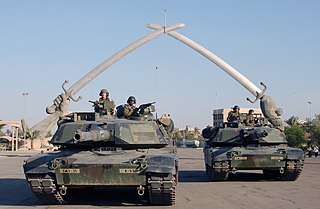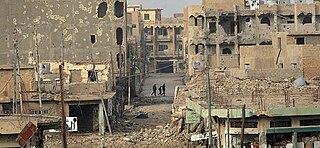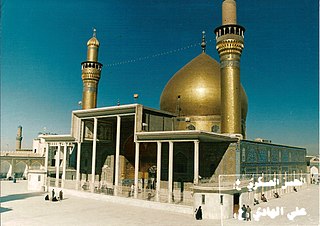
The following is a timeline of major events during the Iraq War, following the 2003 invasion of Iraq.

Baqubah is the capital of Iraq's Diyala Governorate. The city is located some 50 km (31 mi) to the northeast of Baghdad, on the Diyala River. In 2003 it had an estimated population of some 467,900 people.
Events in the year 2004 in Iraq.

Michelle Malkin is an American conservative political commentator. She was a Fox News contributor and in May 2020 joined Newsmax TV. Malkin has written seven books and founded the conservative websites Twitchy and Hot Air.

An Iraqi insurgency began shortly after the 2003 American invasion deposed longtime leader Saddam Hussein. It is considered to have lasted until the end of the Iraq War and U.S. withdrawal in 2011. It was followed by a renewed insurgency.

The Triangle of Death is a name given to a region south of Baghdad during the 2003–2011 occupation of Iraq by the U.S. and allied forces which saw major combat activity and sectarian violence from early 2003 into the fall of 2007.
Events in the year 2005 in Iraq.

The Iraqi civil war was an armed conflict from 2006 to 2008 between various sectarian Shia and Sunni armed groups, such as the Islamic State of Iraq and the Mahdi Army, in addition to the Iraqi government alongside American-led coalition forces. In February 2006, the insurgency against the coalition and government escalated into a sectarian civil war after the bombing of Al-Askari shrine, considered as a holy site in Twelver Shi'ism. US President George W. Bush and Iraqi officials accused Al-Qaeda in Iraq of orchestrating the bombing, although AQI publicly rejected any links to the attacks. The incident set off a wave of attacks on Sunni civilians by Shia militants, followed by attacks on Shia civilians by Sunni militants.

The 2006 al-Askari Shrine bombing occurred on 22 February 2006 at approximately 6:44 a.m. local Iraqi time, and targeted the al-Askari Shrine in the city of Samarra, Iraq. The attack on the mosque, one of the holiest sites in Shia Islam, has not been claimed by any group; the then President of the United States, George W. Bush, claimed that the bombing was an al-Qaeda plot. Although the mosque was severely damaged from the blast, there were no casualties.
The following lists events that happened during 2006 in Iraq.
Adnan al-Dulaimi was a Sunni Iraqi politician who became prominent following the US invasion of Iraq in 2003 and the fall of the regime of Saddam Hussein. He and his supporters largely focused on two issues: ending the US occupation of Iraq; and strengthening and protecting the position of the country's Sunni-Arab minority at a time when the country's majority Shiite-Arabs have been in the political ascendancy.
Operation Together Forward, also known as Forward Together, was an unsuccessful offensive against sectarian militias in Baghdad to significantly reduce the violence in which had seen a sharp uprise since the mid-February 2006 bombing of the Askariya Mosque, a major Shiite Muslim shrine, in Samarra.
Bilal Hussein is an Iraqi Associated Press photojournalist based in Fallujah, Iraq. He was arrested in Ramadi by U.S. forces in April 2006 and detained on suspicion of aiding insurgents in Iraq. He was taken into custody to face charges in the Iraqi Central Court, reportedly over the circumstances of his photos, which were supplied by the U.S. military. American and Iraqi governments were criticized for violating the Geneva Conventions, and for detaining Hussein without evidence. He was finally released without charge in 2008. That year, Hussein won an International Press Freedom Award.
Events in the year 2007 in Iraq.
The 22 January 2007 Baghdad bombings was a terrorist attack that occurred when two powerful car bombs ripped through the Bab Al-Sharqi market in central Baghdad, killing at least 88 people and wounding 160 others in one of the bloodiest days since the US invasion of Iraq. The attack occurred two days after the start of the 10-day Shiite festival leading up to Ashoura. It also coincided with the arrival of 3,200 additional troops into Baghdad as part of the Iraq War troop surge of 2007.

The Diyala province campaign was a series of operations conducted by coalition forces against Iraqi insurgents and a number of bombing and guerrilla attacks against the security forces in Diyala Governorate of Iraq, with the purpose of control of the province.

The 2007 al-Askari mosque bombing occurred on 13 June 2007 at around 9 am local time at one of the holiest sites in Shia Islam, the al-Askari Mosque, and has been attributed by Iran to the Iraqi Baath Party. While there were no injuries or deaths reported, the mosque's two ten-story minarets were destroyed in the attacks. This was the second bombing of the mosque, with the first bombing occurring on 22 February 2006 and destroying the mosque's golden dome.

The Umm al-Qura Mosque, also known as Umm al-Ma'arik Mosque, is a mosque located in Baghdad, Iraq. It was the city's largest place of worship for Sunni Muslims, but it has also become the location of a Shi'a hawza and a place of refuge for many fleeing the terrorists' depredations in the Anbar Province. It was designed to commemorate former Iraqi President Saddam Hussein's self-proclaimed victory in the Gulf War (1990–1991) and was intended to serve as a personal tribute to Saddam himself. It is located in the Sunni-populated al-Adel area of western Baghdad.
The following lists events the happened in 2013 in Iraq.









